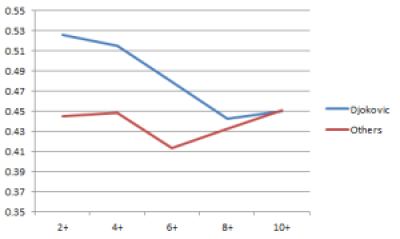Italian translation at settesei.it
When Novak Djokovic stands on the other side of the court, you’d better make some first serves.
Djokovic is one of only two players this year to win more than 55% of second-serve-return points (David Ferrer is the other). When you consider that he also wins more than 35% of first-serve-return points, it’s less clear that the server has much of an advantage. In fact, when Novak is performing at that level, if his opponent goes through a bad patch and only makes a quarter of his first serves, Djokovic has a better than 50% chance of breaking serve.
Commentators often refer to Djokovic’s return as a weapon, and they’re not joking. Only six players (including Novak himself and, invariably, John Isner) won as many second-serve points as Novak won second-serve-return points.
What’s most remarkable about his return game is how quickly he neutralizes the second serve, often using tactics that, in the hands of lesser mortals, would be more appropriate for service points. Unlike other returners, he is somewhat more likely to win a short return point than a long one. While other players need a few shots to negate the advantage conferred by serving, Djokovic is most effective early in service points.
This graph shows the percentage of second-serve-return points won by Djokovic, by rally length, in four matches I’ve charted (US Open vs Stanislas Wawrinka and Rafael Nadal; Tour Finals vs Wawrinka and Juan Martin del Potro), compared to the the same percentage for other top-ten players (excluding Rafael Nadal) in 19 other matches I’ve charted from the US Open and Tour Finals this year:
When the return lands in play, Djokovic wins almost 53% of return points, while the pack manages less than 44%. (All of these matches are between top-ten opponents, so the averages are much lower than season numbers, which are affected by matches against lesser opponents.) The difference stays about the same when we take out 2- and 3-shot rallies.
When we limit our view to points that reach six shots, Novak still has a substantial edge, roughly 48% to 42%. But in points longer than seven shots, there’s virtually no difference.
Djokovic’s return is so good that if his opponent misses his first serve, the point has turned into a Novak service point. Opponents are forced to fight their way into their own service points!
This was particularly true in the Djokovic-Nadal US Open final. (Follow the link, then click the ‘Serve Influence’ tab for a shot-by-shot winning percentage breakdown.) Nadal won barely half of his second-serve points when Djokovic got his return in play, but once the rally reached five shots (or six, or seven, and so on), Nadal had the edge, winning 60% of points. From the five-shot mark, Rafa’s advantage only increased.
Of course, Nadal won that match. It’s not quite so useful to convert return points into service against an opponent whose own return of serve is so effective. To win today, Novak needs to do more than just attack Rafa’s second serve. He must either do so even more effectively than he did in New York, or put himself in a better position to win longer return points after the effect of his return has worn off.
